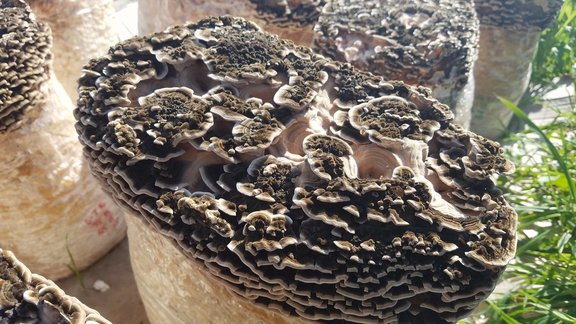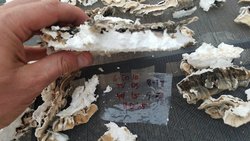
This mixture is then loaded and sealed into bags fitted with a micro-porous filter patch, which allow air exchange, while stopping bugs or mold spores.
[As the mycelium slowly digests the substrate, CO2 is released, making these bags a safe carbon dioxide generator for indoor cannabis grow operations.]
After colonization of the substrate is complete, the turkey tail begins to grow a thick stipe (stem-like) layer in the CO2-rich environment of the bag.
[As the mycelium slowly digests the substrate, CO2 is released, making these bags a safe carbon dioxide generator for indoor cannabis grow operations.]
After colonization of the substrate is complete, the turkey tail begins to grow a thick stipe (stem-like) layer in the CO2-rich environment of the bag.
 Click photo for 'day 1 outside' album.
Click photo for 'day 1 outside' album.
This growth response is the same that reishi growers use to induce the antler-form.
The mushrooms use this type of growth:
The mushrooms use this type of growth:
- to reach toward open air (as if they were emerging from underground, or under bark) where they can most successfully distribute their spores.
- to create architecture for their caps to form and drop their spores when they are growing on a horizontal top surface.
 Click photo for 'Day 2-10 outside' album
Click photo for 'Day 2-10 outside' album
After this stipe development stage, the bags are opened and set outside under shade cloth. Turkey tail caps immediately start to form on the stipe layer.
 Click photo for '10-28 days outside' album
Click photo for '10-28 days outside' album
During cap formation, they are remarkably tolerant to weather changes and will reliably produce throughout the Vermont growing season (Mid-April through October).
 Click photo for 'Mature Turkey Tails' album
Click photo for 'Mature Turkey Tails' album
After 5 weeks, the caps are mature and the block is ready to harvest.
[You could let them grow another week or 2, but it's not worth the increased risk of fungal, algal and bacterial contaminants.]
The stipe layer allows the harvester to peel the whole top off of the sawdust block in one piece, and scrape off any remaining substrate. This makes harvest very efficient and ensures that the mushrooms are fully separated from the substrate. (link to harvest video from previous page)
[You could let them grow another week or 2, but it's not worth the increased risk of fungal, algal and bacterial contaminants.]
The stipe layer allows the harvester to peel the whole top off of the sawdust block in one piece, and scrape off any remaining substrate. This makes harvest very efficient and ensures that the mushrooms are fully separated from the substrate. (link to harvest video from previous page)
|
Mature turkey tail can be successfully grown in 2, 3 and 4 month cycles (inoculation to harvest).
The 4 month cycle is the most cost-efficient and results in the thickest stipe-layer; and therefore, the higher beta-glucan content. See Analysis page. 
~2 months growth
|

~3 months growth

~4 months growth. At 0.72 lb., this block had the highest harvest weight among 250 units.
|
This growing method is the culmination of several years of research. I believe it represents the most economically efficient way to produce top-quality turkey tail mushrooms. At $50 per pound, that is $0.11 cents per 1000 mg of dried Trametes versicolor, and at 50.8% (1-3)(1-6) beta-glucan content, that is $0.22 per 1000 mg of extractable beta-glucan.
To my knowledge, there are few turkey tail products, grown in North America, that result in development and harvest of fruitbodies. This video by Paul Stamets shows the only other commercial attempt that I've seen.
To my knowledge, there are few turkey tail products, grown in North America, that result in development and harvest of fruitbodies. This video by Paul Stamets shows the only other commercial attempt that I've seen.